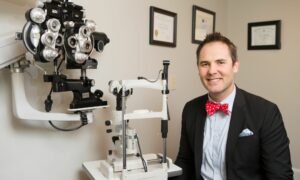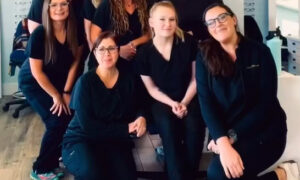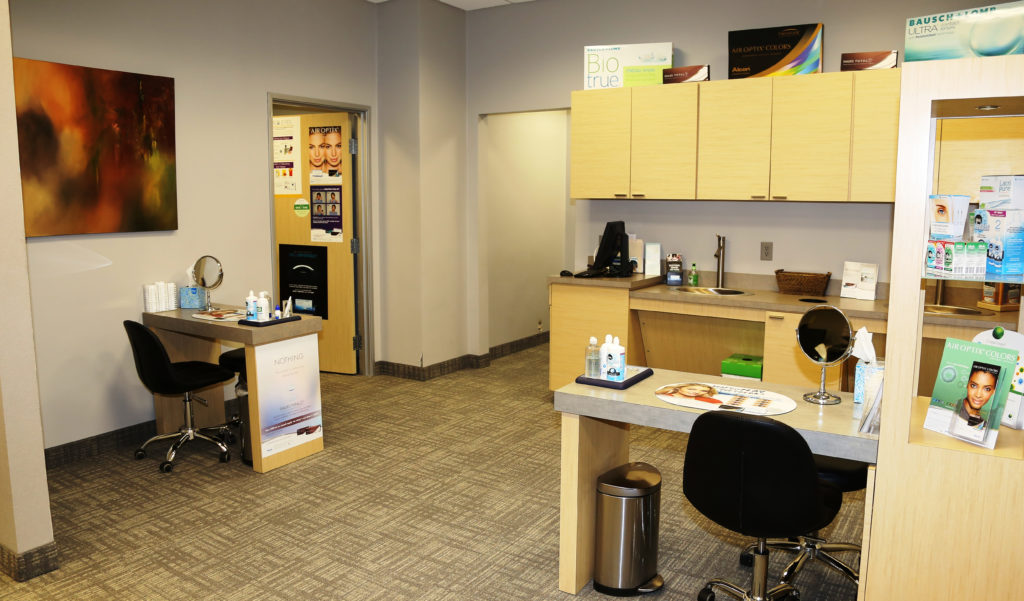
The contact lens room in Dr. Krivacic’s practice. Thinking strategically about contact lens inventory and shipment to patients can make a huge difference to profitability, Dr. Krivacic says.
By Ken Krivacic, OD, MBA
April 5, 2017
Contact lenses are an important part of my three-doctor practice.
Studies show that contact lens patients return more frequently for office visits and contribute more revenue over time than do eyeglasses-only patients.
New advances allow us to fit a wider range of patients with contact lenses–and improve the lives even of patients who have been told in the past they are not good candidates.
For these reasons, we have made this sector of our practice a center for growth and profitability.
The strategies I outline in this article can be applied to any-size practice, but it should be noted at the outset that my practice is larger than the average U.S. optometric practice. The average U.S practitioner has revenues from their practice of $600,000 per doctor. Our practice averages 1 million per doctor. The numbers provided can be extrapolated to reflect what the average would be in the reader’s practice.
In 2016, we saw just over 3,200 patients who came in for a contact lens evaluation, of the 8,000 patients who came in last year for exams. That number represents close to 40 percent of our patient volume. In our practice it is difficult to have an exact count of those who purchase from us as opposed to taking their contact lens prescription elsewhere to purchase. But I would estimate that we lose close to 30 percent of our contact lens sales to outside sources. So, despite our success, we still have room for improvement.
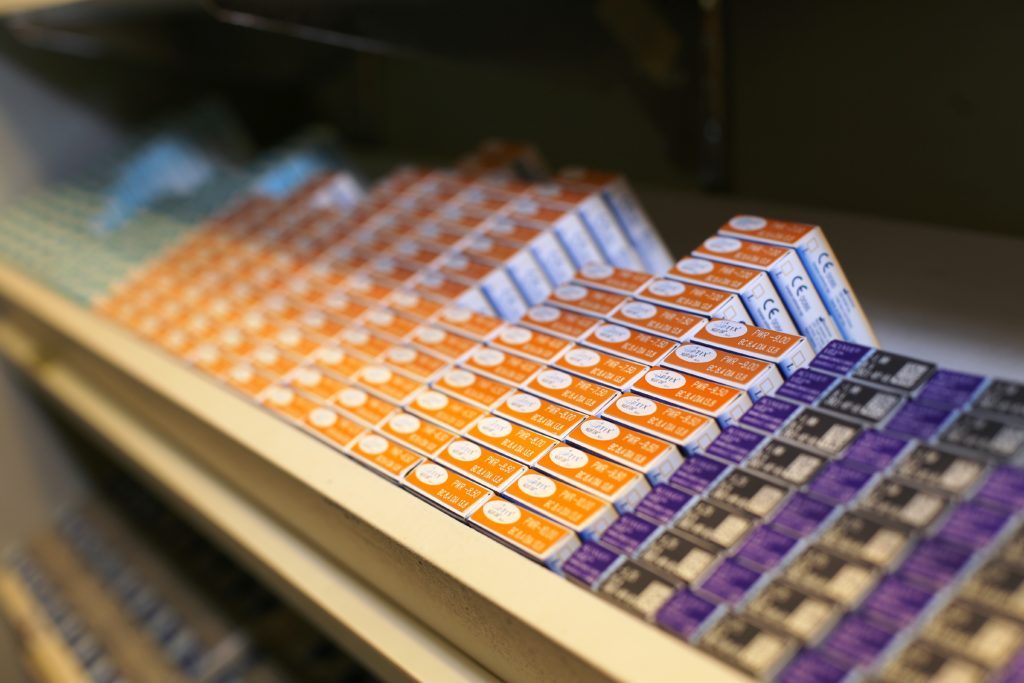
Contact lens inventory in Dr. Krivacic’s practice. Shipping contacts directly to patients, and ordering contact lenses in bulk, can reduce costs and make contact lens inventory and sales more profitable.
Track to Grow
We track the revenue generated from contact lenses in our practice in two areas: revenue from contact lens professional fees, and revenue from the sale of contact lens materials.
In 2016, we generated close to $221,000 in revenue in contact lens professional fees, which represented close to 7 percent of total practice revenue. The sale of contact lenses themselves was just over $620,000, which represented close to 20 percent of total practice revenue.
The total revenue from contacts represents close to 27 percent of our total annual practice revenue of $3.3 million. The U.S. average is close to 19 percent of revenue generated in a practice from the sale of contact lenses.
The number of contact lens patients in our office has increased by 4 percent per year over the past three three years. The revenue generated in professional fees has matched that growth over the same three years. Our revenue from the sale of contact lens materials has increased by an average of 8 percent per year over the last three years.
According to The Vision Council, the U.S. contact lens market grew by nearly 3 percent in 2016. Grand View Research explains this growth as the result of a larger user base, especially as more options are available in contact lenses, and the aging population has also led to an increase in sales. A large part of the aging population looks at contact lenses as a way to turn back the hands of time.
I am happy with the continued growth in the sale of contact lenses in our practice. Nationally, independents have slowly lost ground in the sale of contact lenses. According to research from Statistca.com, in the period from 2010 to 2012, independents went from garnering 40.6 percent of contact lens sales in 2010 to 39.5 percent in 2012. During that same time period, chains went from 18.3 percent in 2010 to 18.6 percent in 2012, mass merchandisers/clubs went from 23.8 percent in 2010 to 23.1 percent in 2012 and “other” (probably internet-based sellers) went from 17.3 percent in 2010 to 18.8 percent in 2012.
So, how do we as independents slow down, or stop, the erosion of our contact lens practices? There is not an easy answer to the question, but there are several strategies that I believe can continue to make the fitting and sale of contact lenses profitable for a private practice.
Pre-Set Patient for CL Purchase in Exam Room
The first place to halt the erosion of our contact lens practices is the exam room. As optometrists we need to actively promote contact lenses for each patient who is a candidate, and has not worn lenses in the past.
For established contact lens wearers we should constantly promote new innovations in contact lenses. Rather than just refit that patient into the same monthly lens they have worn for the past four years, offer new products. We have moved our contact lens patient base to 75 percent daily disposable products by discussing and offering patients healthier and more convenient alternatives.
I know what you are thinking. You’re asking, “But what about cost? My patients aren’t going to pay the higher price of daily disposables.” My response is you don’t know until you ask. Give the patient a chance to say “no.” In the words of the great hockey player Wayne Gretszky: “You miss 100 percent of the shots you never take.”
Besides, most of us do not purchase based on price alone. We purchase based on value. Value is a combination of price and benefits. In contact lenses, if you only discuss price, you would never sell any daily disposable products. Mention the health benefits, the no-cleaning convenience, the great feel of that fresh lens every day, and more patients than you expect will upgrade to daily disposable contact lenses.
The research firm GfK has noted that from June to November 2015, daily SKUs accounted for 31 percent of U.S. Soft Contact Lens dollar sales – up from 16 percent in the same period four years earlier. Meanwhile, weekly lenses have dropped from 44 percent of sales to 28 percent in the same four-year time frame. Monthly lenses have remained flat, but maintain market dominance, posting 40 percent of sales in 2015 versus 39 percent in 2011.
Partner with Staff to Drive CL Sales
Our staff is vital to the success of our contact lens business. They are charged and empowered with explaining fees and prices – our doctors do not. Another task for our contact lens techs is to follow-up with patients who are trialing contact lenses, and close the sale, or have the patient return if there are any complications for the doctor to address.
Training for the staff is ongoing. There are constantly new products, and consequently, new prices to learn. We have weekly staff meetings, and devote part of that time to contact lens training and updates. The contact lens staff also participate in meetings with our vendors to stay up to date. We usually do those as a lunch meeting, so they can learn in a less stressed environment and get a free lunch.
Ask CLs Vendors for Help Selling Their Products
Vendors can be a great resource in helping keep contact lens sales in-house. The annual supply rebates that vendors can provide has helped boost our contact lens sales tremendously. These rebates can make your office price competitive with other retailers, especially online retailers.
Taking advantage of bulk purchases from vendors can also help the bottom line. Many vendors will offer a lower price on products when making a large purchase. But be careful not to over-buy, which can result in a large inventory that can make cash flow difficult. We usually reserve large purchases of our top-selling contacts.
Along with vendors, a distributor can provide other benefits to make your practice more competitive. We use ABB OPTICAL GROUP as our contact lens distributor, and they help us by streamlining the ordering process, and providing us with useful data.
Through ABB and our EHR system we can place orders throughout the day, and then batch them at the end of the day, to place one order per day. Not only does this streamline the process, but it saves shipping costs by placing one order rather than several per day.
Our distributor also provides us with a monthly report of our sales. This is particularly useful when vendors offer bulk-order promotions. We can refer to our report and only order those lenses that we use a lot and are sure to sell. The last thing you want is a great price on contact lenses that then just sit on your shelf.
Let Patients Try New CLs for at Least One Week
If the patient is hesitant about upgrading, we offer to let them try the contact lenses for a week before they make their purchase decision. A majority of patients end up purchasing daily disposable contact lenses once they are able to experience the benefits of that product over the course of a week. To reduce our chair time, we offer to contact them by phone, e-mail or text in one week to get their feedback and place the order.
In the area of specialty lenses, we offer a 90-day money back on the product if they are not satisfied in that time period. Last year, when we saw over 3,200 contact lens patients, we handed out just 12 refunds. We want to make the patient feel comfortable in their purchase.
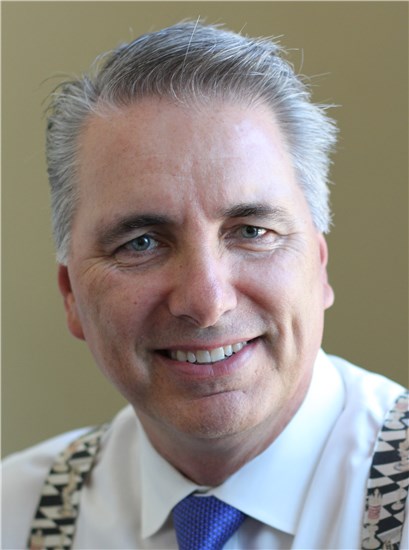 Ken Krivacic OD, MBA, is the owner of Las Colinas Vision Center in Irving Texas. To contact him: kkrivacic@aol.com.
Ken Krivacic OD, MBA, is the owner of Las Colinas Vision Center in Irving Texas. To contact him: kkrivacic@aol.com.



